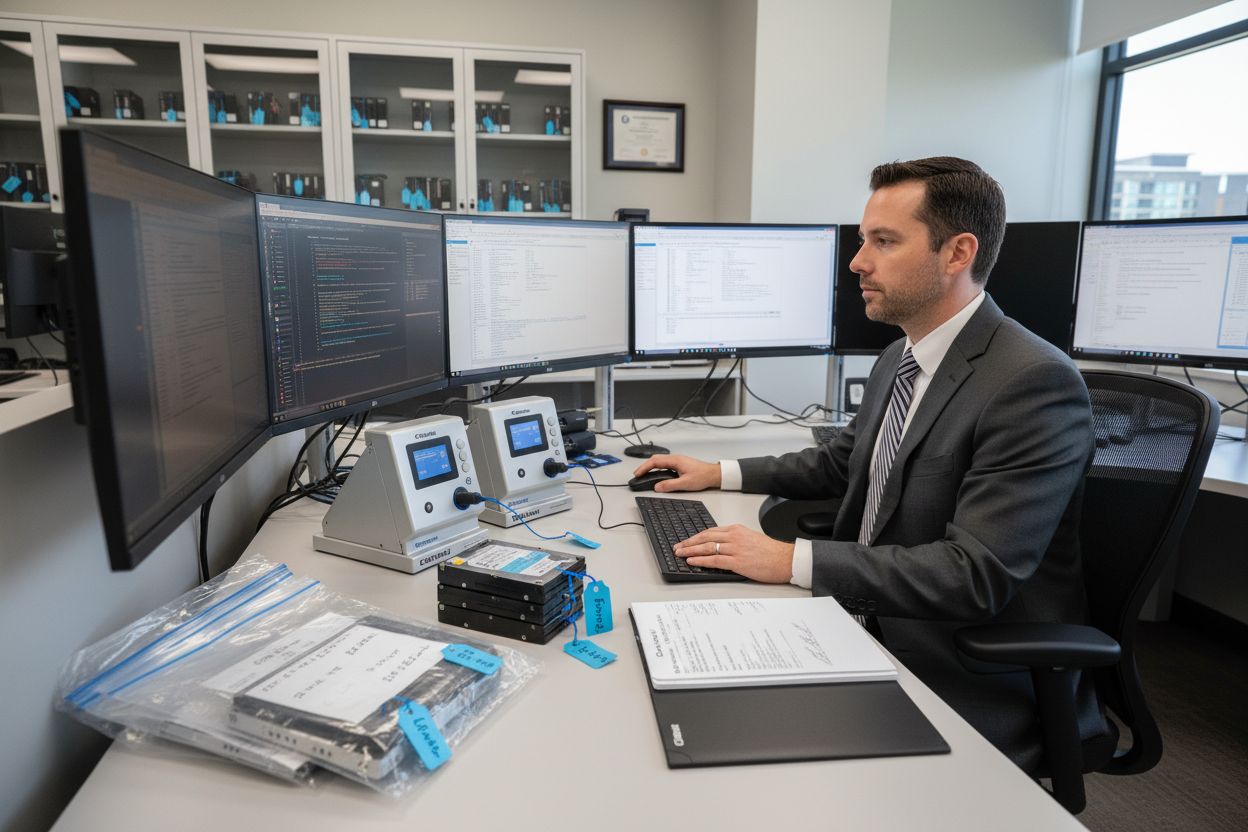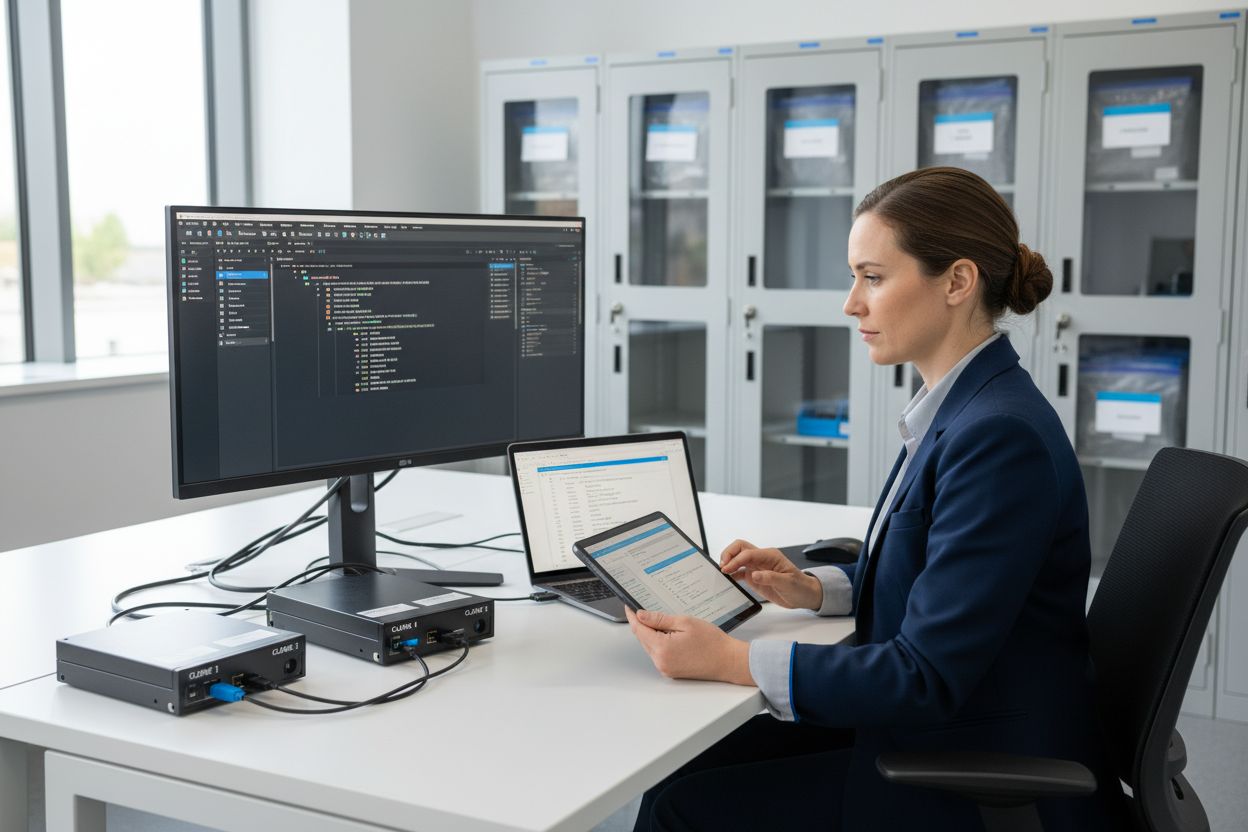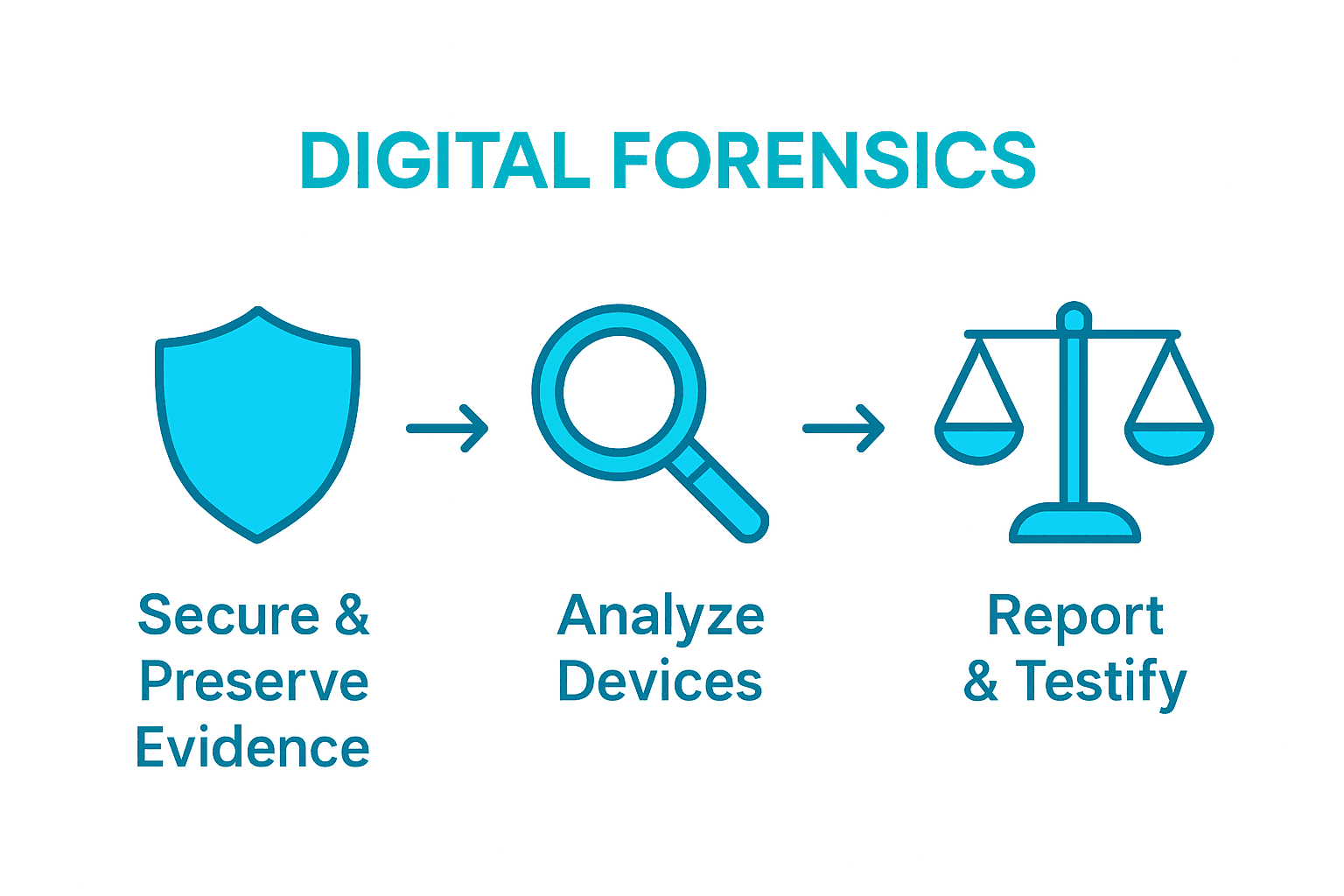Did you know that over 90 percent of criminal cases now involve digital evidence? Computers and mobile devices hold crucial clues for investigations of all kinds. Whether you are tasked with tracing intellectual property theft or supporting a legal case, knowing how to handle and analyse digital evidence is vital. This guide helps you navigate each phase to gather, protect, and present digital findings with confidence and precision. Computer Forensics Specialists play a key role in this process.
Table of Contents
- Step 1: Assess Your Case And Objectives
- Step 2: Secure And Preserve Digital Evidence
- Step 3: Conduct Forensic Analysis Of Devices
- Step 4: Document Findings And Generate Reports
- Step 5: Support Legal Proceedings And Testimony
Quick Summary
| Key Point | Explanation |
|---|---|
| 1. Document Initial Case Assessment | Create a thorough record of your investigation needs, objectives, and background information to maintain a clear audit trail. |
| 2. Secure Evidence with Best Practices | Utilize forensic environments and write blockers to preserve original evidence integrity, ensuring it is not altered throughout the investigation. |
| 3. Maintain Detailed Logs During Analysis | Record all actions, tools, and methodologies during forensic examination to allow for accurate replication of your process by others. |
| 4. Generate Comprehensive Reports | Document findings and the context of your procedures clearly to create a legally defensible narrative that is understandable to non-technical stakeholders. |
| 5. Prepare for Court Testimony | Review and practice explaining technical findings in simple terms, ensuring your investigation meets the highest forensic standards for legal presentation. |
Step 1: Assess Your Case and Objectives
In the intricate world of computer forensics, your first critical step involves thoroughly understanding the specific requirements and goals of your investigation. According to the United Nations Office on Drugs and Crime (UNODC) guidance, this initial assessment requires meticulously documenting what digital evidence you need to obtain, why you need it, and how you will acquire it.
Begin by gathering comprehensive background information about your case. This means connecting with your client or legal representative to understand the precise objectives. Are you investigating potential employee misconduct? Searching for evidence of intellectual property theft? Collecting data for a potential legal proceeding? Each scenario demands a unique forensic approach.
As recommended by the Scientific Working Group on Digital Evidence (SWGDE), you must review all provided documentation carefully. This helps determine the necessary forensic processes and establishes clear communication about any potential legal restrictions or required authorisation. Pay special attention to the specific digital platforms or devices relevant to your investigation.
Tip: Always document your initial case assessment comprehensively. This creates a clear audit trail and helps maintain the integrity of your forensic investigation.
Your next phase will involve preparing your forensic examination environment and selecting appropriate investigative tools. By establishing a clear roadmap from the start, you set the foundation for a thorough and legally sound digital investigation.
Step 2: Secure and Preserve Digital Evidence
After assessing your case objectives, the next critical phase involves securing and meticulously preserving digital evidence. According to the United Nations Office on Drugs and Crime (UNODC), maintaining a robust chain of custody is paramount in digital forensic investigations.
Begin by creating a secure forensic environment where evidence cannot be accidentally modified or contaminated. This means using write blockers when handling digital storage devices and working exclusively with forensic duplicates of the original data. Your goal is to ensure that every piece of digital evidence remains in its original state, precisely as it was when first collected.
According to the National Institute of Standards and Technology (NIST), digital evidence preservation requires careful handling across multiple platforms. Each device or data source demands specific preservation techniques. For computers, this might involve creating forensic disk images. For mobile devices, it could mean extracting data through specialised forensic tools that prevent data alteration.
Pro Tip: Always document every single action during evidence collection. Record timestamps, hash values, and specific methodologies used to maintain complete transparency.
Understanding chain of custody procedures becomes crucial in this stage. Each transfer of evidence must be meticulously logged, indicating who handled the evidence, when, and under what circumstances. This documentation creates an unbroken trail that can withstand legal scrutiny and ensures the admissibility of your digital evidence in court.
Here’s a summary of critical actions for securing and preserving digital evidence:
| Action | Importance | Best Practice |
|---|---|---|
| Use forensic environment | Prevents contamination | Isolate workspace Use write blockers |
| Create forensic duplicates | Maintains evidence integrity | Work only with copies |
| Log chain of custody | Ensures legal admissibility | Record handlers Track timestamps |
| Handle devices appropriately | Prevents data alteration | Use device-specific techniques |
| Document all actions | Provides transparency | Record every step and tool |
Step 3: Conduct Forensic Analysis of Devices
With your digital evidence securely preserved, you are now ready to begin the intricate process of forensic device analysis. According to the Scientific Working Group on Digital Evidence (SWGDE), this stage requires meticulous preparation and a systematic approach to extracting meaningful information.
Start by establishing a controlled, isolated examination environment. This means creating a workspace completely disconnected from network systems to prevent any potential external data contamination or interference. Validate all forensic tools before beginning your analysis to ensure they produce consistent and reliable results.
The SWGDE Best Practices emphasize comprehensive documentation throughout the examination process. This involves creating detailed logs of every action taken, including the specific tools used, methodologies applied, and observations made during the investigation. Your documentation should be so precise that another forensic expert could replicate your exact steps.
Warning: Never conduct forensic analysis directly on original evidence. Always work with forensically copied disk images to maintain data integrity.
Comprehensive mobile device forensics guide can provide additional insights into the nuanced techniques required for different digital platforms. Each device type requires unique forensic approaches whether you are examining computers, smartphones, tablets, or cloud storage systems. Your goal is to extract all relevant digital artifacts while maintaining the pristine condition of the original evidence.
Step 4: Document Findings and Generate Reports
After completing your forensic device analysis, the next crucial step involves meticulously documenting your findings and generating comprehensive reports. According to the Scientific Working Group on Digital Evidence (SWGDE), this stage requires precise record keeping and systematic documentation of your investigative process.
Begin by compiling contemporaneous notes that capture every detail of your forensic examination. This means recording the exact methodologies used, tools employed, and specific observations made during your investigation. Your documentation should provide such comprehensive detail that another forensic expert could recreate your entire investigative process from your notes.
According to research from the Mosse Cyber Security Institute, your report must transparently outline not just your findings but also the context, limitations, and specific procedures used in your investigation. This means explaining the tools used, any potential constraints encountered, and providing a clear narrative that connects your technical findings to the broader investigative context.
Pro Tip: Maintain a chronological log of every action taken during the forensic investigation, including timestamps and specific methodologies used.
Understanding chain of custody procedures becomes critical when generating your final report. Ensure that your documentation creates an unbroken trail of evidence that can withstand legal scrutiny, demonstrating the integrity and reliability of your forensic investigation. The goal is to produce a report that is not just technically accurate but also legally defensible and comprehensible to non technical stakeholders.
Step 5: Support Legal Proceedings and Testimony
The final stage of your digital forensic investigation involves preparing to present your findings in legal proceedings. According to the International Organization on Computer Evidence (IOCE), this requires meticulous documentation and handling of digital evidence by forensically competent professionals.
Prepare for potential court testimony by ensuring your investigation meets the highest standards of forensic integrity. This means being ready to explain every technical detail of your examination process, demonstrating how you maintained the chain of custody and preserved the original evidence. Professional guidance emphasizes that your expert testimony must adhere to Rule 702, which requires that your methods be scientifically reliable and based on verifiable facts.
Your testimony should translate complex technical findings into clear, understandable language for legal professionals who may not have a technical background. Practice explaining your methodologies, tools used, and the significance of your discoveries in a straightforward manner that judges and juries can comprehend.
Warning: Your credibility as an expert witness depends entirely on the precision and integrity of your forensic investigation.
Why use digital forensics in litigation provides additional context for legal professionals seeking to understand the critical role of digital forensic evidence. Your ultimate goal is to present a compelling, scientifically sound narrative that supports the legal proceedings while maintaining the highest standards of professional integrity and technical expertise.
Discover Expert Computer Forensics Support for Your Investigation
When facing the challenge of securing, analysing, and presenting digital evidence, you need more than just knowledge—you need trusted professionals who understand the critical importance of maintaining chain of custody and delivering legally defensible results. Whether you are battling complex cybercrime, employee misconduct, or intellectual property theft, the stakes are high and the pressure intense. Don’t risk the integrity of your investigation or your case outcomes.
Computer Forensics Lab specialises in comprehensive digital forensic services from evidence preservation to expert witness testimony. Our skilled team offers advanced solutions tailored to your needs including Computer Hacking Examination and expert witness support through Computer Forensics Expert Witness. Act now to secure trustworthy digital evidence and clear, compelling forensic reports that stand up in court. Visit Computer Forensics Lab to learn how we can support your investigation every step of the way.
Frequently Asked Questions
How do computer forensics specialists assess my case and objectives?
Computer forensics specialists begin by thoroughly understanding the specific requirements and goals of your investigation. Connect with them to provide background information about your case and define the unique forensic approach needed based on your situation, such as employee misconduct or intellectual property theft.
What steps do computer forensics specialists take to secure and preserve digital evidence?
They create a secure forensic environment to prevent contamination and use forensic duplicates of original data. Ensure you have protocols in place that include using write blockers and logging the chain of custody to maintain evidence integrity throughout the process.
How do specialists conduct forensic analysis of devices?
Computer forensics specialists methodically analyze digital evidence by working in a controlled, isolated environment. You can expect them to validate tools and document every step in detail, ensuring that the entire analysis is replicable.
What should I expect in the documentation and reporting process?
Expect a comprehensive report that outlines methodologies, findings, and any limitations encountered during the investigation. Specialists will maintain meticulous notes, allowing you to understand the context of their findings in a clear and accessible manner.
How can computer forensics specialists support legal proceedings?
They prepare to present findings in court, ensuring that all evidence is handled and documented to meet legal standards. To get ready for this, you can discuss the importance of communicating your findings in a way that legal professionals can understand, potentially simplifying complex technical details.
Why is maintaining a chain of custody important in digital forensics?
The chain of custody is critical as it ensures the credibility and reliability of the digital evidence in legal contexts. Implement strict logging procedures for evidence handling to avoid questions about integrity, demonstrating a clear trail that supports legal admissibility.


